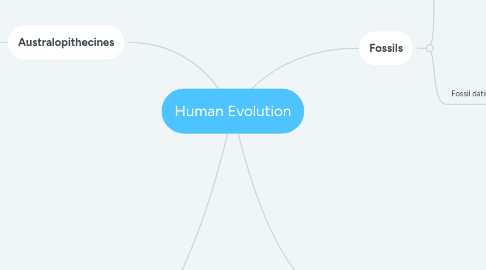
1. Australopithecines
1.1. Australopithecines first appeared around 5 million years ago and are the early ancestors of homo sapiens. First, ardipithecus ramidas evolved into australopithecus anamensis about 4 millio years ago, which in turn evolved into australopithecus afarensis 500,000 years later. After this, the evolutionary line splits into several species, with one of these branches ultimately turning into homo sapiens.
1.2. There were two main types of Australopithecines - robust and gracile. The main difference between the two was found in the skull, particularly the components used to chew and eat.
1.2.1. Robust Australopithecines had large, deep jaws with large teeth inside. This suggests that robust australopithecines' diets probably consisted mostly of hard nuts and seeds. Examples are africanus, robustus, sebida, and aethiopicus.
1.2.1.1. Fun Fact: Australopithecus Boisei is considered to be 'hyper-robust' due to their immense jaw, teeth, and face muscles.
1.2.2. Gracile Australopithecines had large anterior teeth (relative to their robust counterparts' cheek teeth). This suggests gracile types were omnivorous. Examples include anamensis, afarensis, platyops, and garhi.
1.2.2.1. Lucy, an australopithecus afarensis, was the first fossilized remains found to prove australopithecines were bipeds.
2. Genus Homo
2.1. The first species in the genus homo is homo habilis, which lived around 1.8 to 2.5 MYA. Next came homo erectus, which lived from .3 to 1.8 MYA. Finally, homo sapiens (modern humans) came about around 0.3 MYA.
2.2. There are several characteristics that set homos apart from other hominin genuses. First, homos are hallmarked by their markedly bigger brain and body size, reduced jaw and teeth size, and a decrease in sexual dimorphism. Some non-physical attributes that set them apart were their use of improved tools, the utilization of fire, and a reliance on culture.
2.2.1. Important to know: the aforementioned physical, mental and cultural changes allowed homos to more easily adapt to new environments. This allowed homos to be the first hominins to leave Africa and in turn spread around the globe.
2.3. archaic homos
2.3.1. Neanderthals were late archaic homos who followed the homo trend of increased brain size and decreased tooth and jaw size. This species was found in Western Asia and Europe, proof of homo migration out from Africa. Although neanderthals have the reputation of being very primitive, this is not totally true. Neanderthals used complex tools, hunted, had their own language and even their own complex cultures.
2.3.2. Archaic homo refers to the species after homo erectus who ultimately died out. Other than neanderthals, evidence shows other archaic homo species also existed: Denisovans, homo naledi, and homo floresiensis.
3. Fossils
3.1. Fossils are the remains of once living organisms that were either covered soon after death or underwent chemical replacement, leading to the organisms' remains turning to rock.
3.1.1. Fossils are useful to anthropologists for various reasons. Fossils help them more accurately date organism remains. In addition, they give anthropologists a brief window into what the environment looked like in the past. Last, fossils give anthropologists physical, concrete evidence of an organism/species existence.
3.1.1.1. Important to know: even with decent fossils, scientists still often struggle with identifying early hominin and primate species due to the often high levels of sexual dimorphism.
3.2. Fossil dating techniques
3.2.1. The first technique is relative dating. The idea behind relative dating is to date fossils in the order of events, rather than an exact numerical age. The chief method for relative dating is superposition. The general idea is that the lower in the earth something is, the older it tends to be.
3.2.2. On the other hand, if you want to know a numerical approximation for a fossil's age, there are absolute dating techniques.
3.2.2.1. Radiometric techniques produces an age approximation using radioactive decay. There are several absolute radiometric dating techniques:
3.2.2.1.1. Carbon-14 dating. This method is used on organic material, as organic materials absorb carbon-14 and stop when they die off. Once the organism dies, it begins decaying into nitrogen-14, allowing scientists to then date the organism.
3.2.2.1.2. Potassium Argon dating. This method is used on inorganic materials that contain potassium. It works the same as C14 dating, but with different isotopes. Some examples include mica and feldspar.
3.2.2.1.3. Uranium dating. This method of dating is used on materials that contain uranium. Again, it measures the radioactive decay of uranium isotopes. Examples include uraninite and zircon.
4. Early Hominins
4.1. Early hominins began developing traits and characteristics that made them branch off from the rest of the primates. First, early hominins began walking on their two hind legs, also known as bipedalism. This occurred 6-8 million years ago (MYA). Some other characteristics evolved are: non-honing chewing (5 MYA), use of tools and speech(2.5 MYA), and finally hunting(2 MYA). Additionally, early hominins continued to develop larger brain sizes. Although larger brains require high energy levels, it allowed early hominins evolve to be more complex and intelligent.
4.1.1. Important to know: bipedalism is a relatively rare form of locomotion, and it comes with several pros and cons. While bipedalism allows you to see greater distances, ability to travel(run) farther, frees up the hands for other vital activities, and makes transportation easier, it also makes hominins much more vulnerable to aging,increases visibility and exposure to predators, and makes it harder to pump blood throughout the body.
